Abstract
Religious panel paintings (icons) play a pivotal role in the rituals of the Eastern Orthodox Christian Church. However, their continuous use often results in physical degradation, prompting remedial interventions. Quite commonly, alterations were treated by simply applying new paint layers directly over the decayed original, while in some cases, old icons were overpainted merely as a means to renovate and modernize them. Therefore, numerous overpainted icons are currently housed in churches, museums, and private collections across Greece. This study focuses on the investigation of a post-Byzantine icon of Christ Pantokrator, which displays extensive overpainting while retaining a few visible fragments of the original composition. The objective was to assess the extent and condition of preservation of the original artwork, to identify materials and techniques used both in the initial painting and in subsequent restoration phases, and to distinguish between those phases. To achieve these aims, a fully non-invasive diagnostic methodology was implemented, including visible light photography, ultraviolet radiation imaging (UVR/UVL), hyperspectral imaging (MuSIS HS), infrared reflectography (IRRef), X-ray radiography, and macroscopic X-ray fluorescence scanning (MA-XRF). The findings confirm that the original painting remains substantially preserved and is of high artistic quality. Moreover, analysis revealed at least two distinct phases of overpainting, likely dating from the 20th century, while the results suggest that the original artwork probably dates to the first half of the 18th century. The study highlights the need to use complementary techniques in order to non-invasively assess complex artifacts like overpainted icons and offers valuable insights into historical restoration practices providing foundation for future conservation planning.
1. Introduction
Religious icons hold both artistic and spiritual significance within the Eastern Orthodox Christian tradition. These paintings are often subjected to extensive use and exposure over centuries, leading to deterioration and subsequent interventions, which may or may not respect the original composition. Overpainting, in particular, has been a common method to refresh or restore damaged icons, often obscuring original layers beneath newer ones. In fact, the term overpainting refers to any paint layer covering original material, which may often be applied over areas of damage including damaged paint layers and exposed underlayers [1]. The primary reason for applying an overpainting is most often the aesthetic enhancement of an altered painting and the restoration of its visual integrity. Therefore, such interventions may involve either local or overall application of new paint layers, while occasionally the craftsmen who executed the overpainting interventions marked their names and the corresponding dates as well [2]. Nevertheless, overpaintings were occasionally applied over old yet sound paintings too, merely as a means to renovate and adapt them according to the contemporary aesthetic trends.
In the context of Eastern Orthodox Christian religious practices, portable panel paintings (henceforth icons) are considered sacred and functional objects even if they have undergone severe damage. As a result, rather than replacing them, church stakeholders often chose to “repair” them by—among other types of interventions, see [3]—overpainting the original in order to preserve the liturgical role of the icon. In this framework, overpainting can range from minimal local interventions such as those on the figures in Michael Damaskinos’s “Last Supper” icon [4] and local overpaintings and retouchings on a Cypriot Virgin Mary icon [5], to complete covering of the originally synthesis with a replication or even a new theme like the notable 16th century Saint Athanasios [6,7] and other icons [8]. Far more rare is the case of overpainting a non-religious theme over an existing icon, and there are only few pertinent examples in the current literature [9]. Of course, there did exist instances of extreme decay where interventions would not work anymore, and it is worth noting that, in these cases, the icons should be treated like holy relics and be buried “in a pure place” [10].
Interestingly, overpainting interventions were frequently intended to conceal areas of loss or were caused by harsh cleaning attempts [11]. In addition, the latter were often performed following really aggressive procedures that employed ingredients like lye and implements like cuttlefish bone [3]. The characteristics of overpaintings vary depending on the painting skills of the person who performed the intervention and may range from crude and primitive overpainting [7] to elaborate imitations of the original style, while only rarely the “restorer” restricted himself to compensating only for the fully lost sections to preserve the intact original areas [12].
It has been stated that overpainting became a dominant restoration practice in the 20th century [12], posing challenges for modern conservation. Identifying the extent and condition of such interventions and their substrate requires diagnostic techniques beyond visual observation, and despite the current development in pertinent analytical techniques, the process is often challenging [8]. Decisions about removal depend on numerous factors like condition, age, and historical value of both the original painting and later interventions, as well as the role of the artifact and the place it will be presented after conservation. However, the ethics beyond the simple “leave it or remove it” question are in fact rather complex, and a thoughtful consideration shall always precede relevant decisions [13,14]. In some cases, even the original artist’s own revisions are revealed through imaging methods and are left intact as per modern conservation ethics, while decision making might prove even more complicated in the case of interventions (particularly some dated to the 19th century) that may reflect ideological motives, aesthetic revisionism, or commercial enhancement for resale [15].
In any case, however, the identification and documentation of the materials and state of preservation of the overpaintings and the underlying paint(s) is essential for both the sound assessment of the artifact and the establishment of a proper conservation plan. Analytical techniques allow for the in-depth investigation of paintings, while novel imaging techniques offer the potentiality of revealing hidden layers through a completely non-invasive approach [8,16,17,18,19]. In the current work, authors investigate a particularly interesting, heavily overpainted icon (i.e., religious panel painting) of Christ Pantokrator (ΠΑΝΤΟΚΡΑΤΩΡ: the omnipotent lord of the universe/the almighty ruler) that measures 65.0 × 45.0 × 3.1 cm3 and originates from a private collection in Skyros Island, Aegean Sea (Figure 1).
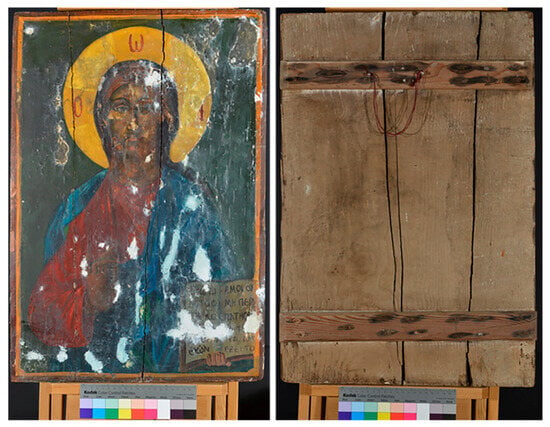
Figure 1.
The recto (Left) and verso (Right) of the Christ Pantokrator icon in the visible (VIS).
At first sight, the stylistic features of the painting suggest that it was created by a non-particularly talented folk artist of the early 20th century. For instance, Christ’s left hand that holds the Gospel has been rendered by simply marking crude finger outlines on the flat, pale brown flesh-like color (Figure 2 Left), and this approach deviates substantially from the typical—in the framework of post-Byzantine painting—multi-layered and rather complex way of rendering flesh parts (for a pertinent example, see Figure 1 in [10]) (Figure 2 Left). However, careful macroscopic observation reveals certain areas of the painting that show substantially deviating stylistic features that are consistent with a much higher level of artistry and can be likely attributed to a considerably earlier period (see, e.g., the left part of His face, in particular the rendering of the hair and the eyes, Figure 2 Right). Additionally, a first assessment indicates that the panel of the icon shows tool marks that suggest manufacturing using hand tools (saw and curved adze, see next and Figure 3); hence, a pre-industrial dating of the wooden support is suspected. This makes it clear that the painting bears at least two different phases of painting, and it is obviously an overpainted icon.
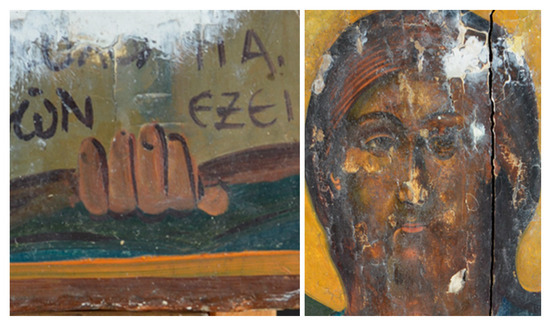
Figure 2.
VIS (Left) Christ’s left hand. (Right) Christ’s face.
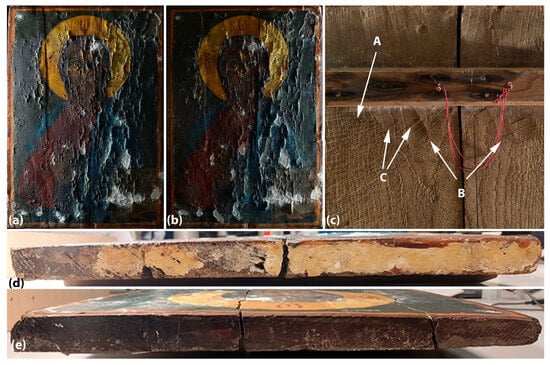
Figure 3.
(a,b) The icon under raking light, from the left and right side respectively. (c) Detail of the rear of the icon, raking light, tool mark: A: saw kerf likely created by a two men’s frame saw; B: hollowed facets likely created by a curved adze; C: rigged lines of wood in each facet are attributed to the dented cutting edge of the adze. (d) Lower transverse panel side showing slow growth tree rings; plank originating from a position close to the pith; the off-white substance corresponds to priming material/gesso (presumably pertaining to the later interventions). (e) Top transverse side, with uneven saw cutting marks.
On this basis, it was decided to subject the painting to a meticulous non-invasive investigation in order to seek the hidden painting and assess its extent and state of preservation. To this goal, a multimodal methodology was adopted. In particular, photography was employed to document the state of preservation and the surface morphological features of the icon, as well as to support technological interpretation. High-resolution digital imaging, under symmetrical and, particularly, under raking light, can reveal key surface features such as structural irregularities, varnish alterations and paint losses, that pertain to its construction technology and current condition [20,21]. Ultraviolet-induced visible luminescence (UVL) photography was employed to assess the surface characteristics of the painting and to potentially detect prior interventions on the icon. The method exploits near-UV (UV-A, 300–400 nm) radiation to excite certain substances, which fluoresce in the visible region of the electromagnetic spectrum [20,21]. In addition, this method allows for the spotting of differences in fluorescence among materials, thus aiding the identification of varnishes, pigments, and structural anomalies [22,23]. Infrared reflectography (IRR) was employed to investigate subsurface features and assess the condition of the painted layers. The technique uses near-infrared radiation (760–2200 nm) to penetrate the surface and record reflectance differences between layers [20,21,24,25]. Since the camera used was sensitive up to 1700 nm, it was particularly useful for identifying underdrawings, overpainted zones, and past interventions. Hyperspectral imaging facilitates the detection of underdrawings, overpaintings, and material inconsistencies and provides information regarding the possible consistency of the pigments [26,27,28,29,30]. X-ray radiography (XRR) relies on differential absorption of X-rays based on material density and composition [31], and in this case, it was employed to investigate the internal structure and condition of the icon. In addition, XRR is capable of revealing various hidden structural features (joins, nails, etc.), and it also contributes to identifying areas with high or low absorption, thus offering insights into the paintings’ materials and state of preservation. Finally, macroscopic X-ray fluorescence (MA-XRF) spectroscopy was used to perform a detailed elemental analysis on the surface of the icon [32]. In fact, this technique allows for the detection and the differentiation between the original painting materials and those that pertain to later interventions/overpaintings [32,33,34].
2. Materials and Methods
The investigation of the icon was based on an entirely non-invasive approach and aimed primarily on the identification of the painting’s materials and techniques and the distinguishment between the original painting and the later additions. First, the icon was photographed using symmetrical and raking light, and subsequently, images were acquired concerning ultraviolet-induced visible luminescence (UVL) and infrared reflectrography (IRR). A hyperspectral camera was employed to provide infrared false-color images (IRFRFC). The two infrared cameras were also compared against each other regarding the reveal of underdrawings on the panel painting. The artifact was subjected to X-ray radiography too. Data pertaining to the elemental composition of the artifact was collected through the employment of macroscopic scanning X-ray fluorescence (MA-XRF) analysis, which revealed the distribution of the various detectable chemical elements on the painting. The relevant technical details are presented in the following paragraphs.
2.1. Photographic and Stereoscopic Documentation
In the framework of the current study, images (symmetrical illumination at 45° and raking light at 5°) were captured using a NIKON D800 DSLR camera equipped with NIKKOR micro 60 mm and 24–70 mm lenses. Two RJ78 halogen lamps were employed for lighting. A proper lighting support system and Kodak color and grayscale guides were also used to ensure consistent results. Additionally, the icon was thoroughly investigated using a Leica Wild M3B stereomicroscope.
2.2. Ultraviolet-Induced Visible Luminescence (UVL)
UVL photography was conducted in a darkened room using a NIKON D800 with a NIKKOR 24–70 mm lens, while illumination was provided by two Philips MLW 160 W black lights placed at a 45° angle relative to the painting. A KODAK WRATTEN 2E filter was used to compensate for excess blue radiation stemming from the light sources.
2.3. Infrared Reflectography (IRR)
The employed imaging system included a Goldeye P-008 SWIR Cool camera (Allied Vision, Stadtroda, Germany) with an InGaAs sensor (900–1700 nm), and KOWA CCTV lenses (16 mm and 50 mm) (Kowa Optimed Deutschland GmbH, Dusseldorf, Germany). Illumination was provided by two tungsten lamps angled at 45° relative to the object’s surface. Due to the camera sensor’s rather small resolution, a virtual grid was applied to the icon for alignment and collection of multiple successive shots, greyscale images were captured across the surface [21,27,35,36]. Selected details of particular interest—especially various overpainted areas—were further documented.
2.4. Hyperspectral Imaging (MuSIS HS)
Hyperspectral imaging was conducted using a MuSISTM HS camera (Forthphotonics Ltd. (then Dysis), Heraklion, Greece), which operates across a spectral range from 370 to 1000 nm. The system, equipped with a 1/2″ Progressive Scan CCD sensor (1600 × 1200 px), enables the selection of 34 spectral bands and offers functions including visible (VIS), near-infrared (NIR), and infrared reflectance false-color (IRRFC) imaging [37]. RGB composites and infrared reflectance false-color (IRRFC) images were produced to distinguish between visually similar but chemically distinct areas. ΙRRFC combines two bands from the visible namely green and red with a third band from the infrared and produces colored images. These images bear no similarity to the colored visible ones and therefore are called false-color infrared images. The output contains the three-colored RBG system (red, green, blue) so the entire gamut of colors can be seen. Based on the false color and therefore the information on whether the pigments absorb or reflect the infrared radiation, a preliminary identification of the pigments can be made. Furthermore, images at separate wavelengths were acquired so as to assist the results obtained by IRR. To optimize detail capture, the icon surface was virtually divided into an eight-section grid. The system’s versatility and robust software suite makes it particularly suited for examining pigment layers and identifying prior interventions in painted artworks.
2.5. X-Ray Radiography (XRR)
A CPI CMP20015 radiographic unit (CPI, Plano, TX, USA) at the University of West Attica was used, and the resulting images were digitized using a Fujifilm FCR CAPSULA system. Due to the panel’s size, four sequential exposures were taken. Exposure settings were adjusted to 60 kVp/14 mAs and 55 kVp/16 mAs to optimize image contrast. Image processing was performed using the Adobe Photoshop software (version CC 2015).
2.6. Macro X-Ray Fluorescence (MA-XRF) Spectroscopy
The analysis was carried out using a Bruker M6-Jetstream system (Bruker Nano GmbH, Berlin, Germany) which is equipped with a 30 W/50 kV Rh tube, polycapillary optics, and an SDD detector. The spectrometer’s head is mounted on a motorized XY stage, and the scanning of the painting was performed by employing a beam diameter of 330 μm, a pixel size (step) of 500 μm, and a dwell time of 12 ms. The entire surface of the icon was scanned resulting in the collection of 1,159,600 individual spectra in approximately 6 h. The spectra were processed into 2D elemental distribution maps using the integrated software of the spectrometer (ESPRIT); an RGB scale bar ranging from black (zero counts) to red (maximum counts) was employed for improved readability of the elemental distribution maps [11].
3. Results
3.1. Visible Light Inspection and Stereoscopic Probing
The observation under raking light revealed the presence of intense surface anomalies obviously pertaining to local detachment of paint layers (Figure 3). An extensive network of craquelure that runs parallel to the height (wood grain) of the panel was documented as well [38], while the several areas of paint losses that have been filled with a white filler show a notably irregular surface denoting a rather haphazard intervention (Figure 3a,b).
The panel of the icon consists of a single piece of wood with physical characteristics (brown-gray color, distinct grains and open pores of early wood on longitudinal surface, medium density/hardness) similar to chestnut (Castanea spp.) (Figure 3c) [39]. It is a tangentially cut plank, from a slow-growth tree, that had a diameter of more than 70 cm, and its thickness is approximately 3.1 cm. Transverse sides indicate that the plank derived from a position close to the pith, and the paint layers have been executed on the inner side of the plank (face looking towards the pith) (Figure 3d,e). The plank is of good quality and has no knots and semi-straight grains. Tool marks on the rear indicate that the plank had been cut from the trunk with a frame saw, as it is evident by the asymmetrical long saw marks (saw kerf marks) [40]. The wood has also been locally treated with an adze as indicated by the hollowed facets that have been created by the strikes of the tool. Fine ridges in the wood on each mark are evident, likely caused by dents existing in the cutting blade of the adze (Figure 3c) [39,41,42,43]. These distinctive features form a “fingerprint” of the panel maker and can operate as an identification characteristic of possible similar panels made by the same craftsman [43,44]. Tool marks on the sides indicate that transverse sides have been cut with a saw, whereas longitudinal sides have been treated with an axe. The dimensions of the panel are inconsistent, with corner angles deviating from a right-angle alignment. The panel-making technology and type of wood share the same characteristics with panels of Northern Greece Icons [41,45].
The panel originally had no cross bars, but later two nailed ones were added, as a method of addressing the broken and cracked panel. The later cross bars were made of planed soft wood with beveled sides and ends and were fastened on the broken panel with machine-made nails that were driven from the cross bar to the panel in two lines and in very close positions to each other. The two cross bars with the very rigid nailing caused further compression set to the panel [39,46] that resulted in the widening of the old cracks or even creation of new ones.
Extremely important was also the meticulous stereoscopic probing of the painting, as it revealed the presence of subject/older paint layers in various areas where the upper paint layers had been detached and lost (Figure 4 Left). Additionally, in the left part of Jesus’ halo, remnants of gilding, red lettering and a cracked, presumably old varnish were spotted too (Figure 4 Right).
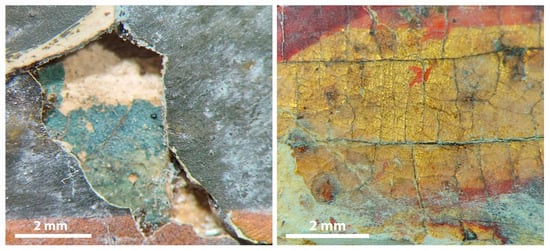
Figure 4.
(Left) An older paint layer (pale-green) revealed in an area of paint loss. (Right) Remnants of gilding covered by a decayed (cracked) varnish; remnants of the authentic lettering are also seen (red, up).
3.2. Ultraviolet-Induced Visible Luminescence
Upon the observation of the icon under UV and through the documentation of the induced visible fluorescence, it was observed that various areas showed an off-yellow/greenish fluorescence with a characteristic morphology that indicates brush application, while others appeared rather dark (Figure 5). Interestingly, in the left part of the face, a slightly different, even (no brushstrokes) and off-white/greenish fluorescence is documented, which can be considered characteristic of natural resins like mastic and sandarac [23,47]. A comparison of various captures from this very detail indicates clearly that this fluorescent substance appears only on the “high-quality painting” areas (Figure 5b,c) and therefore might correspond to the original varnish of the icon; contrarily, the areas of later interventions show no fluorescence and appear mostly detached from their substrate (raking light, Figure 5d), while a brushstroke on Jesus’ eyebrow that appears dark under UV shall be obviously interpreted as a recent restoration/retouching intervention [20]. Finally, the areas where a white filler is exposed show a rather intense purple fluorescence which suggests the presence of chalk [48].
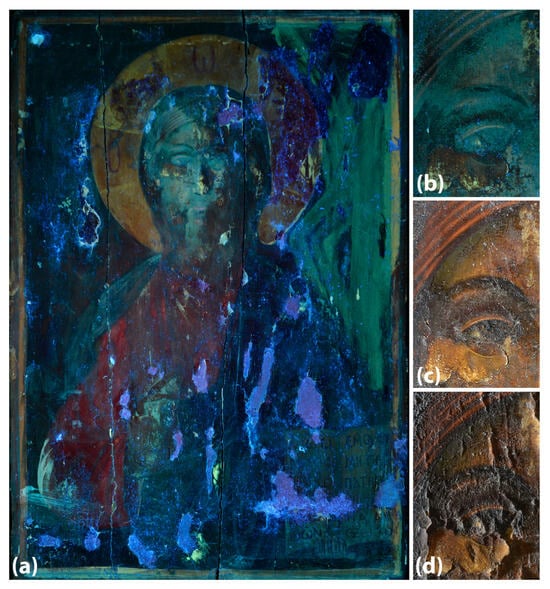
Figure 5.
(a) The UVL of the recto of the icon. (b–d) Details of Jesus’ face left part in UVL, VIS symmetrical and VIS raking, respectively.
Findings like the presence of remnants of two distinct (in terms of fluorescence and pattern) varnishes on the icon along with the identification of non-fluorescent overpaintings clearly suggest that the artifact has undergone multiple restoration interventions.
3.3. Hyperspectral Imaging (HSI) and Infrared Reflectography (IRR)
Infrared reflectography allowed the detection of paint layers that lay below overpainting. Especially in the area of Christ’s face and hair, following the UVL results of the existence of a different varnished area, IRR suggests the existence of a far more detailed original composition. Different lettering beneath the visible overpainting on the Gospel was also identified, confirming that the icon had undergone past restoration interventions which completely covered original elements.
In particular, in the present research, two different cameras were used, both pertaining to the infrared region. Regarding the hyperspectral camera, the image with the best contrast was the one at 960 nm (Figure 6). Being monochromatic, it is not influenced by other radiations; therefore, the information obtained is clearer and refers to deeper layers than those seen by the naked eye. Compared to the visible image, the folds of the mantle and inner garment are recorded in full detail, which enables useful information about the artist’s technique to be obtained. Comparison between the left and right hand at 960 nm is fundamental to proving that these areas have been painted by two different people. The InGaAs camera (IRR) (Figure 6) provided even more information than the image at 960 nm. The IRR image presents high sharpness and contrast and refers to even greater depth than the hyperspectral one. As a result, the area of the face is more clearly depicted and the boundaries between the two artists are more prominent. Even though the 960 nm image showed traces of letters emerging underneath the visible ones on the Gospel, they still are not well shaped and illegible. On the contrary, the IRR image presents in full detail the writing that was later covered and reveals that the original lettering is not preserved on the lower part of the Gospel. Furthermore, the plaits and folds are sharper and better visualized and the artist’s brushstrokes clearly distinguishable.
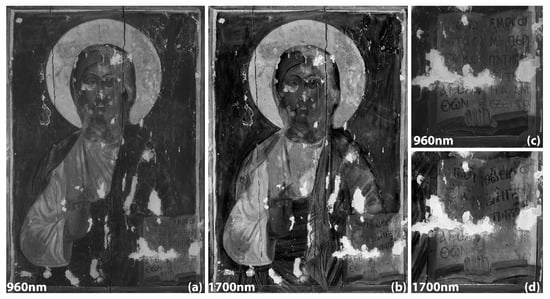
Figure 6.
(a,b) images of the icon through the MuSIS (960 nm) and InGaAs (1700 nm) cameras. (c,d), Details of the Gospel from the latter two images (960nmp & 1700nm respectively).
Furthermore, hyperspectral imaging enabled the acquisition of infrared reflectance false-color images (IRRFC). Apart from enabling a more distinguishable view of the two artistries, this method can discriminate pigments based on their behavior in the infrared region. Regarding the red areas, the pale olive yellow false color indicates the use of either an organic lake or red ochre [49], while the flesh areas, like the hands and the face, produce an olive hued false color, which suggests that earth pigments were used, such as ochres and umbers [50] (Figure 7).
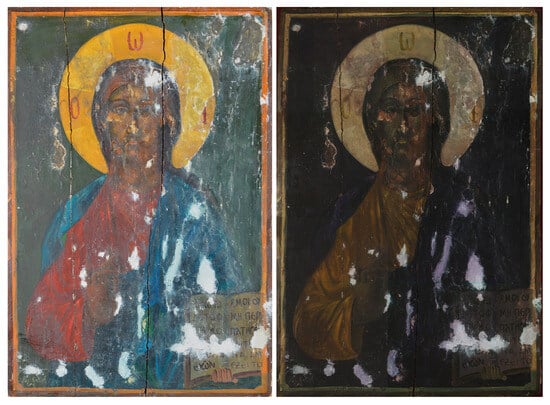
Figure 7.
The Jesus Christ icon in VIS (Left) and the corresponding IRRFC image (Right).
3.4. X-Ray Radiography
X-ray radiography (XRR) revealed important information about the internal structure of the artifact. In particular, XRR highlighted the numerous metallic nails that were used to fasten the two cross bars on the panel and revealed diffusion of the corresponding corrosion products within the wood (Figure 8a). Incised underdrawing is documented in several elements like the blessing hand, the halo, the vestment, and the book, thus revealing notable differences between the original drawing (incised lines) and the visible composition. Note that these very thin lines show increased X-ray absorption in comparison to their surroundings, and this might well suggest that the incisions had been filled by paint(s) containing heavy elements [11]. Additionally, the employment of pigments containing heavy elements in the original painting allowed for the detection of several currently invisible details of the original painting, like the lettering on the right part of the icons’ campus which reads “ΚΡΆΤΩΡ” (pertaining to the iconographic type of the original depiction/“Pantokrator”) (Figure 8a), and the particularly skillful rendering of Jesus’ face and vestments (Figure 8b,c). Also, XRR allowed for the precise mapping of the margins of the areas of original gesso losses, since the white filler does not absorb intensively the X-rays; therefore, the latter areas appear as rather dark spots on the radiograph (Figure 8a, arrows “ii”). It is worth noting, however, that in a couple of areas that have undergone mechanical stresses (the central crack and the lower part of the panel), the radiograph revealed the presence of an intensively absorbing material instead (Figure 8a, arrows “iii”), which clearly indicates that the filling of the original gesso losses was performed with at least two distinct materials and, hence, in two steps.
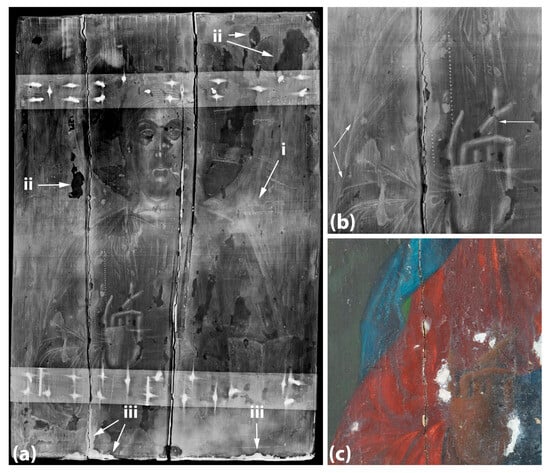
Figure 8.
(a) X-ray radiography of the icon; arrows indicate lettering on the campus (i), a low (ii) and a high (iii) X-ray absorbent filling material. (b) Detail of (a); arrows indicate incised preliminary drawing. (c) Photograph of the detail shown in (b).
However, the area of the face of Jesus Christ turned out to be very interesting. Indeed, this particular area of the radiograph was subjected to image processing in order to reduce the effect of the cross bar that is nailed on the panel’s rear, and the resulting image revealed that below the currently visible, rather hazy image there lays a well-preserved and skillfully executed face (Figure 9).
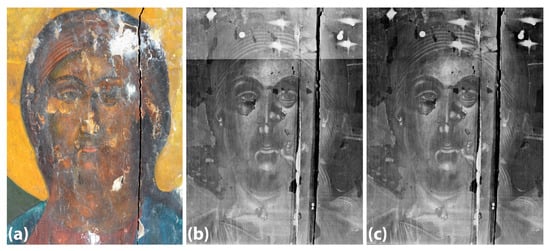
Figure 9.
The area of Jesus Christ’s face in visible (a) and the corresponding part of the X-radiograph before (b) and after (c) image processing.
3.5. Scanning Macroscopic X-Ray Fluorescence Spectroscopy (MA-XRF)
The MA-XRF analysis provided an in-depth understanding of both the original and altered pictorial layers of the icon. Unlike single-point XRF, the macroscopic scanning technique enabled the creation of two-dimensional elemental maps, making it possible to visualize areas of overpainting and restoration. In particular, the MA-XRF analysis of the painting revealed the presence of various chemical elements, yet the corresponding sum spectrum (i.e., the sum of all the individual spectra collected during the scanning) showed predominance of the elements calcium (Ca), iron (Fe), zinc (Zn), and lead (Pb) (Figure 10). The relevant distribution maps suggest that certain chemical elements pertain almost exclusively to the most recent painting which is currently visible on the panel. For instance, Ca is primarily detected on the areas that have been filled using a white material; the absence of sulfur (S), barium (Ba), and zinc (Zn) in these very areas (Figure 10) clearly suggests that the material used for these fillings was a calcium-carbonate substance, which is considered one of the traditionally used materials for the compensation of ground/gesso losses [51]. However, upon careful examination of the relevant elemental distribution maps, one will observe that minor titanium is detected on most yet not all the Ca-dominated fillers, thus indicating employment of two distinct filling materials. Therefore, execution of at least two filling (and inpainting?) interventions is inferred.
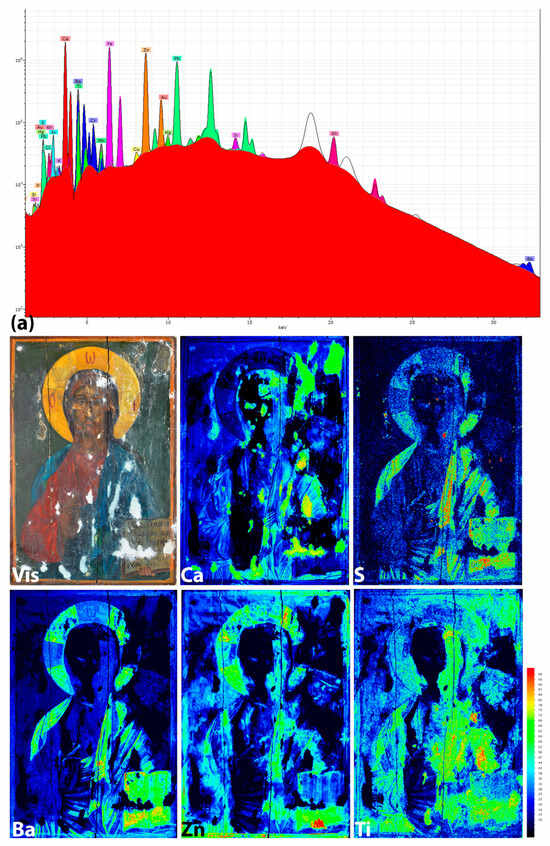
Figure 10.
The MA-XRF sum spectrum (a), followed by a photograph of the icon (Vis) and the distribution maps (MA-XRF) of the chemical elements calcium, sulfur, barium, zinc, and titanium.
High intensities of barium, sulfur, and zinc elemental peaks co-exist in various areas of the painting like the bluish himation and the light-yellow parts of the halo, thus suggesting employment of lithopone, i.e., a BaSO4 plus ZnS artificial mixture which became commercially available on 1874 [52] (p. 248). It is worth noting however that in the upper part of the Gospel where sulfur and barium are detected in exactly the same area, zinc shows a significantly deviating 2D distribution, thus revealing employment of a different compound (not lithopone), presumably baryte. Similarly, the lower part of the Gospel along with the bottom/marginal line of the painting shows intense zinc yet minor Ba and S; therefore, the presence of lithopone shall be excluded here too, and it seems that a zinc oxide compound might have been used there instead (Figure 10). On this basis, the assumption that the painting has undergone at least two past “restoration” interventions is further corroborated.
The distribution of chromium (Cr), yet another element exclusively pertaining to the visible (recent) overpainting of the icon, is also very interesting and informative. In fact, Cr is primarily detected on areas of the yellow-orange halo, the red tunic and the greenish campus (background) of the painting (Figure 11). In the latter case, the presence of Cr may be readily assigned to the employment of chromium oxide green, which is generally thought to have spread in the color market after the mid-19th century [52] (pp. 107–108). Contrarily, at first sight, it appears that in the red and yellow areas (tunic and halo, respectively) Cr is not accompanied by barium (Figure 10) or lead (Pb) (Figure 11), which is indeed a puzzling observation, since the two most plausible candidate groups of Cr pigments are barium and lead chromates [52] (pp. 102–103). However, this is in fact not true, as lead is indeed detected in these very areas; this can be readily seen upon the comparison of the Pb M (M-Alpha 1, ~2.34 keV) versus the Pb L (L-Alpha 1, ~10.55 keV) transition intensity distributions (Figure 11), which reveals the presence of Pb in these areas too. However, it appears that the Pb content of the corresponding Cr pigments is rather low, and for this reason, the intensity of the L transition in these areas is far lower in comparison to that of the Pb-white dominated areas of the original painting (see next paragraph). It is thus clear that one must be particularly cautious when assessing MA-XRF data in order to avoid potential misinterpretations.
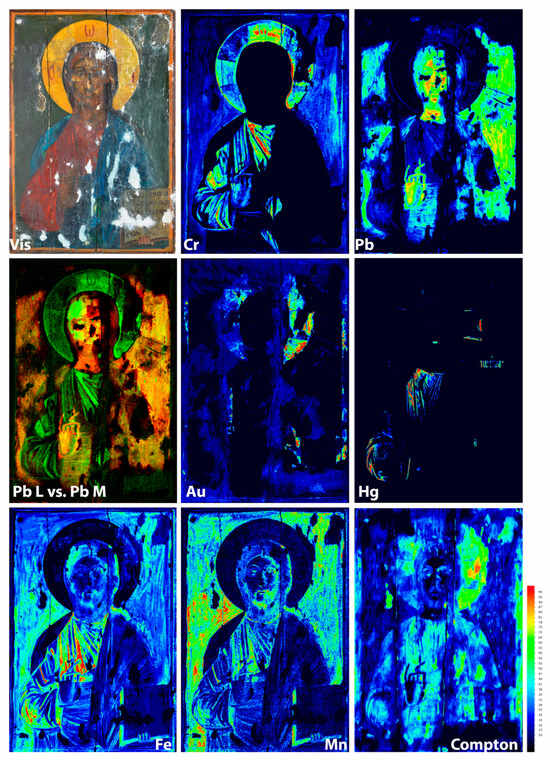
Figure 11.
From upper left to bottom right: Vis image and the distribution maps of the elements Cr, Pb, Pb L vs. Pb M, Au, Hg, Fe and Mn, along with a map showing the distribution of the Compton scattering intensity (for the arrows, see text).
The distribution maps of specific elements and, in particular, lead (Pb), mercury (Hg), and gold (Au) are evidently relevant almost exclusively to the oldest, original painting. In particular, the distribution of Pd highlights in great detail the areas where the original painting is still preserved. In addition, lead white was practically omnipresent in the painting of post-Byzantine icons, as it was extensively used both as a means to render highlights and as a common ingredient of the majority of the corresponding paint layers [7,11,32,53,54]. Additionally, one shall highlight the serendipity that the overpainting layers contain almost no lead; therefore, this element can be safely assigned almost exclusively to the original painting. On this basis, the distribution of lead highlights very clearly the areas of the original painting losses, which are primarily located on the bottom and upper part of the panel, as well as on the edges of the two vertical cracks that run parallel to the height of the panel (Figure 11).
Similarly, intense gold (Au) elemental peaks are detected on the spectra collected from the right part of the halo, from various spots of the outer margin of the painting as well as from the leaves of the Gospel and a ribbon on Jesus’ tunic that were probably originally gilded (Figure 11). These very areas show an intense presence of iron too, thus indicating that the gold leaves were applied by the water gilding technique, i.e., using a bole-based poliment [55]. Interestingly, it appears that traces of gold (pale blue areas on the corresponding map) are spread on a considerable area of the painting, and one might misinterpret these as traces of gilding. Nevertheless, these “low-Au” areas coincide with the areas of high Zn intensity (Figure 10); the photons originating from the K-Beta transition of this very element have an energy of approximately 9.57 keV, which lies very close to the Au L-Alpha transition (~9.63 keV) and hence can be easily misinterpreted. On this basis, it shall be underlined that, apart from its edges, the campus (background) shows no gold and is dominated by lead; hence, it is inferred that the campus was originally painted, not gilded. This detail might be relevant for both the assessment of the dating and the origin of the icon as it is rather infrequently seen in post-Byzantine icons [12,56,57,58].
Mercury (Hg), which is probably present due to the employment of the red mercury sulfide pigment vermilion [59,60], shows also an impressive and really informative distribution. Indeed, the relevant MA-XRF map reveals a very sophisticated and delicate highlighting on the inner, red tunic of Jesus, as well as lettering on the right part of the campus spelling “ΚΡÁΤΩΡ”, part of the word Pantokrator, which defines the iconographical type of Christ’s representation (Figure 11). Additionally, Hg is detected on the halo where it reveals rays and part of the letter “Ν” that pertains to the phrase “Ο ΩΝ” (“He who is”) which is typically inscribed in Christ’s halo. An epsilon (“Ε”) is also revealed on the Gospel, where obviously the initial letter was rendered in vermilion; other minor details like the lips of Christ and details on His hair also contain Hg and hence are revealed on the corresponding MA-XRF elemental distribution map (Figure 11). However, the original, delicate painting of the hair is dominated by iron (Fe, Figure 11); hence, employment of ochre-type pigments is inferred. Nevertheless, Fe is also present in most of the overpainting paint layers like in the area of the campus and in the red tunic. In the latter case, Fe shows an anti-correlation with Cr, which suggests that an Fe-rich pigment was used as a substrate (primary layer or “προπλασμός”) for the Cr-rich highlights. In addition, the simultaneous detection of manganese (Mn) in the same areas (Figure 11) indicates employment of a Sienna- or umber-type pigment, while the MA-XRF data suggests that the same pigment must have been used on the campus as well [60].
Finally, worth noting is the intensity of the Compton scatter; since the Compton scatter intensity decreases as the mean atomic number of the irradiated area increases, areas containing low Z elements show high intensities and vice versa [11]. On this basis, the Compton intensity distribution provides important information that is complementary to that gained through XRR. For instance, in the Jesus Christ icon, the Compton scattering (Figure 11) reveals clearly the wood grain and the Ca-rich filled areas (both of high Compton scattering intensity, arrows i and ii, respectively) as well as the original delicate highlights and ornaments of Christ’s red tunic (low-intensity areas, arrows iii) along with brushstrokes on the campus (arrows iv).
4. Discussion
The multimodal analytical protocol employed for the examination of the Jesus Christ Pantokrator icon led to the thorough investigation of the painting’s stratigraphy, revealing that the currently visible paint layers correspond primarily to recent overpainting, which was executed using modern (i.e., post-19th c.) pigments. Additionally, the employment of various analytical techniques that allow for the visualization of subsurface/hidden layers revealed that a considerable part of the original painting remains rather well preserved below the layers of overpainting. In order to better understand and assess the technical and stylistic characteristics of the original panel, an attempt was made to combine data. A first relevant example is the combination of the MA-XRF elemental distribution maps of lead (Pb), mercury (Hg), and gold (Au), which outlines graphically the original painting (Figure 12a). In fact, the elements Hg and Au are detected exclusively due to the original painting’s components, while Pb is primarily detected in the original painting as well (Figure 12a). However, minor Pb is detected in specific parts of the overpainting too (e.g., halo, see Section 3.5 and Figure 11); therefore, this mapping of the original painting shall be critically treated. Another attempt to reveal the preserved original painting was made through the digital superimposition [20] of MA-XRF, XRR and IRR images (Figure 12b). Once more, the outcome suggests that the original painting is preserved to a considerable extent, and the areas of its loss are quite precisely defined. Moreover, the latter composite image highlights the complementarity of the employed techniques. Indeed, a characteristic example that underscores the need to use multiple analytical techniques is the area of the Gospel. X-ray radiography (Figure 12c) reveals a book outline that deviates substantially from that observed macroscopically and a faint Epsilon initial, while MA-XRF (Figure 12d) reveals the elemental composition of this area and proves that the initial Epsilon letter was rendered in vermilion. However, the original text, written in a far more elaborate manner than the modern one, is visible only via IR reflectography, probably because it was rendered in carbon black which is transparent in X-rays (Figure 12e).
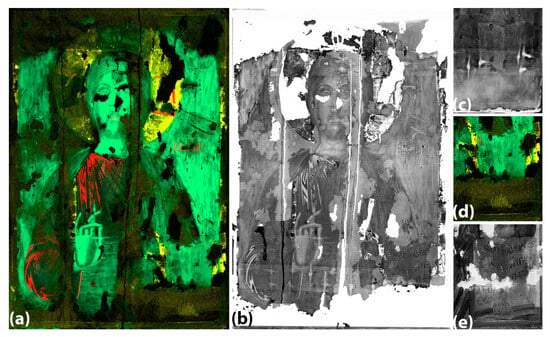
Figure 12.
(a) Digital combination of the MA-XRF distribution maps of the elements lead (green), mercury (red), and gold (yellow). (b) Digitally superimposed images (XRR, MA-XRF, IRR). (c–e) Detail of the Gospel in XRR, MA-XRF (detail of (a)), and IRR, respectively.
Based on the characteristics of the original painting that were revealed through this non-invasive approach, one may attempt to further assess the icon. First, one shall note that the back of the panel shows two men’s frame saw tool marks (Figure 3c), and this hints to a post-16th century dating because the saw became the standard tool for wood manufacturing only during the sixteenth century [42]. In line with this observation are the facial characteristics of Christ which are indeed sophisticated yet show traces of stylization as well (Figure 9). Additionally, it is also relevant that the campus (background) is painted and gilding is reserved only for details like the halo and the margins of the icon (Figure 11). All the aforementioned characteristics suggest that the original painting can most probably be dated to the first half of the 18th century.
Finally, it is important to make a short comment about the future conservation of the icon. It is true that the multimodal, non-invasive methodology employed in the current study revealed that the icon in consideration preserves—in a rather good state—a very interesting and considerably old representation of the icon. At the same moment, it became apparent that the layers covering the original painting (overpainting) are indeed not skillfully executed and of very low artistic value, while they are also considerably later (probably 20th century) than the original (18th century). Nevertheless, the treatment of overpainted artifacts often imposes particularly difficult interventions, and decision making is in many cases a very challenging task; leave it (the overpainting) or remove it? In the pertinent literature, one may encounter cases where the layers of overpainting were either completely or partially removed, while examples of retained overpaintings also exist [7,8,57]. According to Goltz and Stoner [13], there are two main factors that must be taken into account in order to decide how to treat overpainted artifacts: the function of the work and the place of presentation. Although the proposal of a conservation plan for the icon under consideration falls far beyond the scope of the current work, in a first attempt to discuss the issue with the owners of the icon, they expressed skepticism regarding the option to completely remove the overpaintings. This can be well understood, however, if one considers the framework of the paintings, which is in fact that of private prayer/ritual.
5. Conclusions
The study of the Jesus Christ Pantokrator post-Byzantine icon through the use of complementary non-invasive analytical techniques has provided an invaluable look beneath its surface, revealing the original painting which is preserved to a considerable extent. The pertinent data and, in particular, elemental distribution maps (MA-XRF) and hyperspectral (HS and IRR) images prove that the painting has undergone at least two past restoration interventions, both executed after the mid-19th century. Through the complementary use of the employed analytical techniques, the technical and stylistic characteristics of the original painting were documented, thus allowing for the dating of the painting to the first half of the 18th century. Additionally, the detailed documentation of the state and extent of preservation of the original painting will facilitate considerably the planning of future conservation interventions. Ultimately, the current study highlights the need to use complementary techniques in order to non-invasively assess complex artifacts like overpainted icons.
Author Contributions
Conceptualization, G.P.M.; methodology, G.P.M., A.G.A., D.F.A. and T.P.; software, N.V.N., A.A., G.P.M., A.A.K. and T.P.; validation, N.V.N., A.A., A.A.K. and G.P.M.; formal analysis, N.V.N., A.S., A.A.K. and G.P.M.; investigation, N.V.N., A.A., A.A.K. and A.S.; resources, G.P.M., A.G.A., T.P., D.F.A. and G.P.M.; data curation, N.V.N., A.A., A.A.K. and G.P.M.; writing—original draft preparation, N.V.N.; writing—review and editing, G.P.M., A.S. and A.A.K.; visualization, N.V.N., A.A., A.A.K. and T.P.; supervision, G.P.M.; project administration, G.P.M.;. All authors have read and agreed to the published version of the manuscript.
Funding
This research received no external funding.
Data Availability Statement
The original contributions presented in this study are included in the article. Further inquiries can be directed to the corresponding author.
Acknowledgments
The authors express their sincere thanks to the owners of the icon, the Efstathiou family from Skyros Island, for granting access to the artifact and permission to conduct this study. Also, the authors thank the anonymous reviewers for their thoughtful and constructive comments. As a minimal token of gratitude, G.P.M. dedicates this article to the memory of the late Nikolaos Zacharias, who passed away on 20 March 2024. Through the Mercy of God, may his soul rest in peace.
Conflicts of Interest
The authors declare no conflicts of interest.
References
- Nadolny, J. History of visual compensation for paintings. In Conservation of Easel Paintings, 2nd ed.; Routledge: London, UK, 2020. [Google Scholar]
- Bomford, D.; Rothe, A.; Walsh, J.; Roy, A. Panel discussion. In Personal Viewpoints. Thoughts about Paintings Conservation; The Getty Conservation Institute: Los Angeles, CA, USA, 2003; pp. 31–39. [Google Scholar]
- Mastrotheodoros, G.P.; Beltsios, K.G. Sound Practice and Practical Conservation Recipes as Described in Greek Post-Byzantine Painters’ Manuals. Stud. Conserv. 2019, 64, 42–53. [Google Scholar] [CrossRef]
- Αλεξοπούλου-Αγοράνου, Α.; Θεοδωροπούλου, Ο.; Τσαΐρης, Γ. Μελέτη των υλικών και της τεχνικής κατασκευής της μεταβυζαντινής εικόνας «ο Δείπνος ο Μυστικός» του Μιχαήλ Δαμασκηνού. Δελτίον Χριστιανικής Αρχαιολογικής Εταιρείας 1997, 19, 151–166. [Google Scholar] [CrossRef][Green Version]
- Zaprzalska, D.; Georgiou, R.; Gasanova, S.; Bakirtzis, N. Revealing the unseen: Advanced digital imaging and spectroscopy for the documentation and non-invasive analysis of a 16th-century Cypriot composite icon. Herit. Sci. 2024, 12, 170. [Google Scholar] [CrossRef]
- Sotiropoulou, S.; Daniilia, S. Material aspects of icons. A review on physicochemical studies of Greek icons. Acc. Chem. Res. 2010, 43, 877–887. [Google Scholar] [CrossRef]
- Daniilia, S.; Bikiaris, D.; Burgio, L.; Gavala, P.; Clark, R.J.H.; Chryssoulakis, Y. An extensive non-destructive and micro-spectroscopic study of two post-Byzantine overpainted icons of the 16th century. J. Raman Spectrosc. 2002, 33, 807–814. [Google Scholar] [CrossRef]
- Bratitsi, M.; Liritzis, I.; Alexopoulou, A.G.; Makris, D. Visualising underpainted layers via spectroscopic techniques: A brief review of case studies. Sci. Cult. 2019, 5, 55–68. [Google Scholar] [CrossRef]
- Luciani, G.; Pelosi, C.; Agresti, G.; Monaco, A.L. How to reveal the invisible the fundamental role of diagnostics for religious painting investigation. Eur. J. Sci. Theol. 2019, 15, 209–220. [Google Scholar]
- Mastrotheodoros, G.P.; Beltsios, K.G. The Balpis Expansion of the Technical Part of the Hermeneia Painting Manual by Dionysius of Fourna. Stud. Conserv. 2024, 69, 425–451. [Google Scholar] [CrossRef]
- Mastrotheodoros, G.P.; Asvestas, A.; Gerodimos, T.; Anagnostopoulos, D.F. Revealing the Materials, Painting Techniques, and State of Preservation of a Heavily Altered Early 19th Century Greek Icon through MA-XRF. Heritage 2023, 6, 1903–1920. [Google Scholar] [CrossRef]
- Λαζίδου, Δ.; Δροσάκη, Δ. Εγχειρίδιο Συντήρησης Εικόνων από το Εθνικό Μουσείο Μεσαιωνικής Τέχνης Κορυτσάς; Ευρωπαϊκό Κέντρο Βυζαντινών και Μεταβυζαντινών Μνημείων: Θεσσαλονίκη, Ελλάδα, 2008. [Google Scholar]
- von der Goltz, M.; Stoner, J.H. Considerations on removing or retaining overpainted additions and alterations. In Conservation of Easel Paintings; Routledge: London, UK, 2020; ISBN 978-0-429-39991-6. [Google Scholar]
- Martens, M.P.J. ‘Leave it or take it away’: Ethical considerations on the removal of overpaintings. CeROArt Conserv. Expo. Restaur. D’Objets D’Art 2015, 4765. [Google Scholar] [CrossRef]
- Škorja, S. The removal of overpaintings in the case of a newly found painting by Master HGG. Varst. Spomenikov 2010, 45, 218–227. [Google Scholar]
- Andronache, I.; Papageorgiou, I.; Alexopoulou, A.; Makris, D.; Bratitsi, M.; Ahammer, H.; Radulovic, M.; Liritzis, I. Can complexity measures with hierarchical cluster analysis identify overpainted artwork? Sci. Cult. 2024, 10, 1–58. [Google Scholar] [CrossRef]
- Cortea, I.M.; Ratoiu, L.; Chelmuș, A.; Mureșan, T. Unveiling the Original Layers and Color Palette of 18th Century Overpainted Transylvanian Icons by Combined X-Ray Radiography, Hyperspectral Imaging, and Spectroscopic Spot Analysis. X-Ray Spectrom. 2022, 51, 26–42. [Google Scholar] [CrossRef]
- Van Der Snickt, G.; Martins, A.; Delaney, J.; Janssens, K.; Zeibel, J.; Duffy, M.; McGlinchey, C.; Van Driel, B.; Dik, J. Exploring a Hidden Painting below the Surface of René Magritte’s Le Portrait. Appl. Spectrosc. 2016, 70, 57–67. [Google Scholar] [CrossRef]
- Stratis, J.A.; Makarona, C.; Lazidou, D.; Sánchez, E.G.; Koutsoudis, A.; Pamplona, M.; Pauswein, R.; Pavlidis, G.; Simon, S.; Tsirliganis, N. Enhancing the Examination Workflow for Byzantine Icons: Implementation of Information Technology Tools in a Traditional Context. J. Cult. Herit. 2014, 15, 85–91. [Google Scholar] [CrossRef]
- MacBeth, R.; Breare, C. The Technical Examination and Documentation of Easel Paintings. In Conservation of Easel Paintings; Routledge: London, UK, 2020. [Google Scholar]
- Αλεξοπούλου-Αγοράνου, Α.; Χρυσουλάκης, Γ. Θετικές Επιστήμες Και Έργα Τέχνης; Γκόνης: Αθήνα, Ελλάδα, 1993. [Google Scholar]
- de la Rie, E.R. Fluorescence of Paint and Varnish Layers (Part III). Stud. Conserv. 1982, 27, 102–108. [Google Scholar] [CrossRef]
- Nevin, A. Fluorescence for the Analysis of Paintings. In Analytical Chemistry for the Study of Paintings and the Detection of Forgeries; Colombini, M.P., Degano, I., Nevin, A., Eds.; Springer International Publishing: Cham, Switzerland, 2022; pp. 221–245. [Google Scholar] [CrossRef]
- Meo, A.D.; Balbi, B.; Casciello, M.; Vigorito, M.R.; Mormile, P.; Rippa, M. Complementary infrared imaging methods for the structural and technical analysis of a panel painting: Adoration of the Magi by Marco Cardisco. Infrared Phys. Technol. 2025, 145, 105705. [Google Scholar] [CrossRef]
- Gajić-Kvaščev, M.; Klisurić, O.; Andrić, V.; Ridolfi, S.; Nikolić, O.; Pavlović, V.; Korolija Crkvenjakov, D. Anatomy of the Painting: The Study of the Serbian Orthodox Icon from the Turn of the Seventeenth to the Eighteenth Century. Coatings 2024, 14, 854. [Google Scholar] [CrossRef]
- Cucci, C.; Delaney, J.K.; Picollo, M. Reflectance Hyperspectral Imaging for Investigation of Works of Art: Old Master Paintings and Illuminated Manuscripts. Acc. Chem. Res. 2016, 49, 2070–2079. [Google Scholar] [CrossRef]
- Moon, T.; Schilling, M.R.; Thirkettle, S. A Note on the Use of False-Color Infrared Photography in Conservation. Stud. Conserv. 1992, 37, 42. [Google Scholar] [CrossRef]
- Raneri, S.; Lorenzetti, G.; Puccinelli, F.; Merciadri, B.; Palleschi, V.; Rota, S.; Legnaioli, S. The ‘Madonna Delle Grazie’ by Andrea Del Sarto and Giovanni Antonio Sogliani: A Multi-Analytical Study. J. Cult. Herit. 2025, 71, 328–333. [Google Scholar] [CrossRef]
- Cortea, I.M.; Ratoiu, L.; Rădvan, R. Non-Destructive Investigation of a Late Panel Painting by Lucas Cranach the Elder. In Lasers in the Conservation of Artworks, Proceedings of the International Conference Lacona VII, Madrid, Spain, 17–21 September 2007; CRC Press/Balkema: London, UK, 2024; pp. 22–30. [Google Scholar] [CrossRef]
- George, S.; Hardeberg, J.; Linhares, J.; MacDonald, L.; Montagner, C.; Nascimento, S.; Picollo, M.; Pillay, R.; Vitorino, T.; Webb, E.K. A Study of Spectral Imaging Acquisition and Processing for Cultural Heritage; The Applied Research Centre in the Humanities and Press, Ltd.: York, UK, 2017. [Google Scholar]
- Tum, J.; Middleton, A. Radiography of Cultural Material, 2nd ed.; Routledge: London, UK, 2006. [Google Scholar] [CrossRef]
- Mastrotheodoros, G.P.; Asvestas, A.; Gerodimos, T.; Tzima, A.; Papadopoulou, V.; Anagnostopoulos, D.F. MA-XRF Investigation of a 17th Century Icon by the Renowned Painter Theodoros Poulakis. J. Archaeol. Sci. Rep. 2024, 53, 104313. [Google Scholar] [CrossRef]
- Alfeld, M.; Pedroso, J.V.; Van Eikema Hommes, M.; Van Der Snickt, G.; Tauber, G.; Blaas, J.; Haschke, M.; Erler, K.; Dik, J.; Janssens, K. A Mobile Instrument for in Situ Scanning Macro-XRF Investigation of Historical Paintings. J. Anal. At. Spectrom. 2013, 28, 760–767. [Google Scholar] [CrossRef]
- Saverwyns, S.; Currie, C.; Lamas-Delgado, E. Macro X-Ray Fluorescence Scanning (MA-XRF) as Tool in the Authentication of Paintings. Microchem. J. 2018, 137, 139–147. [Google Scholar] [CrossRef]
- Cosentino, A. Infrared Technical Photography for Art Examination. E-Preserv. 2016, 13, 1–6. [Google Scholar]
- Fontana, R.; Barucci, M.; Dal Fovo, A.; Pampaloni, E.; Raffaelli, M.; Striova, J. Multispectral IR Reflectography for Painting Analysis. In Advanced Characterization Techniques, Diagnostic Tools and Evaluation Methods in Heritage Science; Bastidas, D.M., Cano, E., Eds.; Springer International Publishing: Cham, Switzerland, 2018; pp. 33–47. [Google Scholar] [CrossRef]
- Αλεξοπούλου, Α.Γ.; Καμινάρη, Α.Α.; Μουτσάτσου, Ά.; Μπάνου, Π. Απεικονιστικές Τεχνικές στη Μελέτη της Πολιτιστικής Κληρονομιάς; Κάλλιπος: Ζωγράφου, Ελλάδα, 2024. [Google Scholar] [CrossRef]
- Bucklow, S. The Classification of Craquelure Patterns. In Conservation of Easel Paintings; Routledge: London, UK, 2020. [Google Scholar]
- Hoadley, R.B. Understanding Wood: A Craftsman’s Guide to Wood Technology; The Taunton Press: Newtown, Connecticut, 2000. [Google Scholar]
- Macleod, C.A. Archaeological Wood and Woodworking; Elements in Current Archaeological Tools and Techniques; Cambridge University Press: Cambridge, UK, 2025. [Google Scholar] [CrossRef]
- Sampatakos, A. The Unseen Sides of Icons. Panel Construction Technology of Byzantine and Post Byzantine Icons from Paul and Alexandra Canellopoulos Museum of Athens. In Byzantine, Medieval and Modern Studies Centenary of the Paul and Alexandra Canellopoulos Collection; Forthcoming; Μουσείο Παύλου και Αλεξάνδρας Κανελλοπούλου: Αθήνα, Ελλάδα; Volume CAMU 1.
- Stassinopoulos, S. Icon Supports. In The Conservation of Easel Paintings; Wadum, J., Streeton, N., Eds.; Routledge: London, UK, 2020. [Google Scholar]
- Σαμπατάκος, Α. Μελετη Της Τεχνολογίας Κατασκευής Φορέων Εικόνων Κρητικής Τέχνης 15ου–17ου Αιώνα. PhD Thesis, Εθνικό Μετσόβιο Πολυτεχνείο, Σχολή Αρχιτεκτόνων Μηχανικών, Αθήνα, Ελλάδα, 2024. Available online: https://www.didaktorika.gr/eadd/handle/10442/57444 (accessed on 8 August 2025).
- Wadum, J. Historic Overview of Panel-Making Techniques in the Northern Countries. In The Structural Conservation of Panel Paintings: Proceedings of a Symposium at the J. Paul Getty Museum; Getty Conservation Institute: Los Angeles, CA, USA, 1998. [Google Scholar]
- Sampatakos, A. Aspects of Panel Making Techniques of 15th–17th Century Greek Icons. In Proceedings of the Wood Science and Technology III: Methods to Examine Panel Paintings and Their Preventive and Remedial Conservation, Maastricht, The Netherlands, 19–21 October 2023. Maastricht, forthcoming. [Google Scholar]
- Uzielli, L.; Fioravanti, M. Physical and Mechanical Behavior of Wood Used for Panel Paintings. In Panel Painting Technique and Conservation of Wood Supports; Edizioni Firenze: Florence, Italy; pp. 59–80.
- de la Rie, E.R. Fluorescence of Paint and Varnish Layers (Part II). Stud. Conserv. 1982, 27, 65–69. [Google Scholar] [CrossRef]
- Measday, D.; Walker, C.; Pemberton, B. A Summary of Ultra-Violet Fluorescent Materials Relevant to Conservation. Australian Institute for the Conservation of Cultural Material National Newsletter. 2017. Available online: https://aiccm.org.au/network-news/summary-ultra-violet-fluorescent-materials-relevant-conservation/ (accessed on 30 July 2025).
- Mounier, A.; Le Bourdon, G.; Aupetit, C.; Belin, C.; Servant, L.; Lazare, S.; Lefrais, Y.; Daniel, F. Hyperspectral Imaging, Spectrofluorimetry, FORS and XRF for the Non-Invasive Study of Medieval Miniatures Materials. Herit. Sci. 2014, 2, 24. [Google Scholar] [CrossRef]
- Hayem-Ghez, A.; Ravaud, E.; Boust, C.; Bastian, G.; Menu, M.; Brodie-Linder, N. Characterizing Pigments with Hyperspectral Imaging Variable False-Color Composites. Appl. Phys. A 2015, 121, 939–947. [Google Scholar] [CrossRef]
- Fuster-López, L. Filling. In Conservation of Easel Paintings; Routledge: London, UK, 2020. [Google Scholar]
- Eastaugh, N.; Walsh, V.; Chaplin, T.; Siddall, R. Pigment Compendium: A Dictionary and Optical Microscopy of Historical Pigments; Butterworth-Heinemann: Oxford, UK, 2008. [Google Scholar]
- Daniilia, S.; Minopoulou, E.; Andrikopoulos, K.S.; Karapanagiotis, I. Analysis of Organic and Inorganic Materials and Their Application on Icons by Angelos. In Icons by the Hand of Angelos: The Painting Method of a Fifteenth-Century Cretan Painter; Milanou, K., Vourvopoulou, C., Vranopoulou, L., Kalliga, A.E., Eds.; Benaki Museum: Athens, Greece, 2008; pp. 115–150. [Google Scholar]
- Karapanagiotis, I.; Minopoulou, E.; Valianou, L.; Daniilia, S.; Chryssoulakis, Y. Investigation of the Colourants Used in Icons of the Cretan School of Iconography. Anal. Chim. Acta 2009, 647, 231–242. [Google Scholar] [CrossRef]
- Mastrotheodoros, G.P.; Beltsios, K.G.; Bassiakos, Y.; Papadopoulou, V. On the Metal-Leaf Decorations of Post-Byzantine Greek Icons. Archaeometry 2018, 60, 269–289. [Google Scholar] [CrossRef]
- Αχειμάστου-Ποταμιάνου, Μ. Εικόνες Της Ζακύνθου [Icons of Zakynthos]; Ιερά Μητρόπολη Ζακύνθου και Στροφάδων: Αθήνα, Ελλάδα, 1997. [Google Scholar]
- Παπάγγελος, Ι.Α.; Στρατή, Α.; Δανιηλία, Μ. Εικόνων Κάλλος Αθέατον [The Hidden Beauty of Icons]; Ίνδικτος: Αθήνα, Ελλάδα, 2004. [Google Scholar]
- Χατζηδάκη, Ν. Εικόνες της συλλογής Βελιμέζη: επιστημονικός κατάλογος; Μουσείο Μπενάκη: Αθήνα, Ελλάδα, 1997. [Google Scholar]
- Gliozzo, E. Pigments—Mercury-Based Red (Cinnabar-Vermilion) and White (Calomel) and Their Degradation Products. Archaeol. Anthropol. Sci. 2021, 13, 210. [Google Scholar] [CrossRef]
- Mastrotheodoros, G.P.; Beltsios, K.G.; Bassiakos, Y. On the Red and Yellow Pigments of Post-Byzantine Greek Icons. Archaeometry 2021, 63, 753–778. [Google Scholar] [CrossRef]
Disclaimer/Publisher’s Note: The statements, opinions and data contained in all publications are solely those of the individual author(s) and contributor(s) and not of MDPI and/or the editor(s). MDPI and/or the editor(s) disclaim responsibility for any injury to people or property resulting from any ideas, methods, instructions or products referred to in the content. |
© 2025 by the authors. Licensee MDPI, Basel, Switzerland. This article is an open access article distributed under the terms and conditions of the Creative Commons Attribution (CC BY) license (https://creativecommons.org/licenses/by/4.0/).